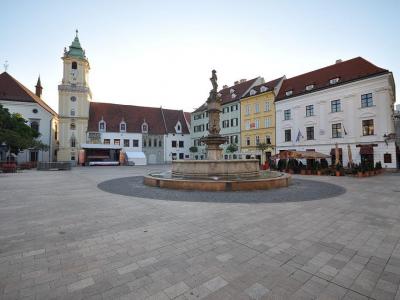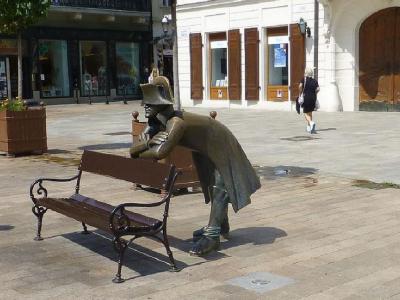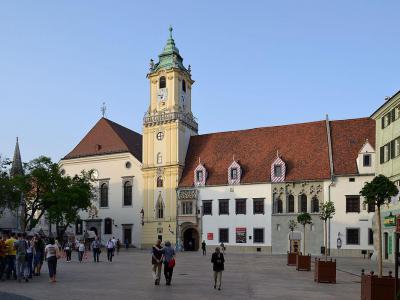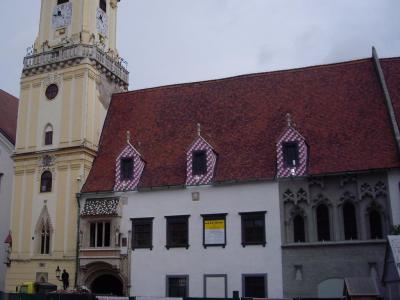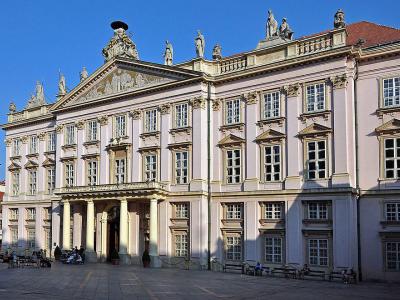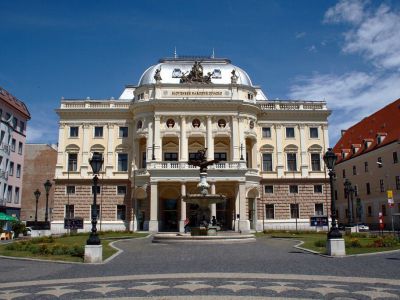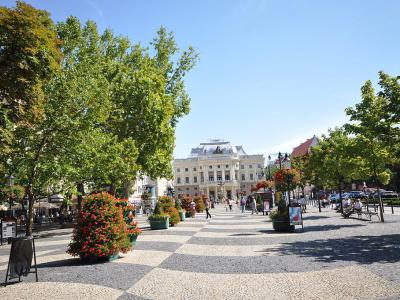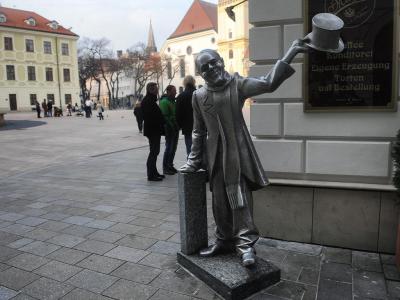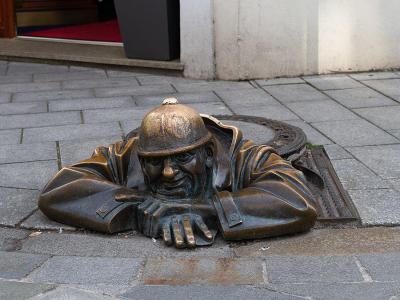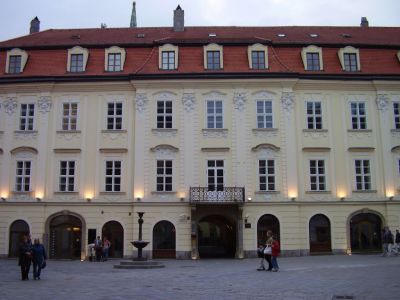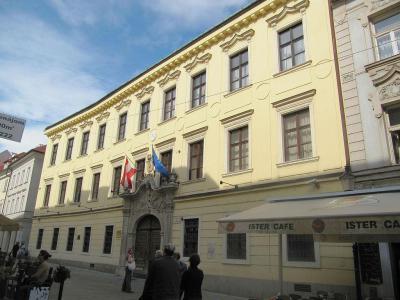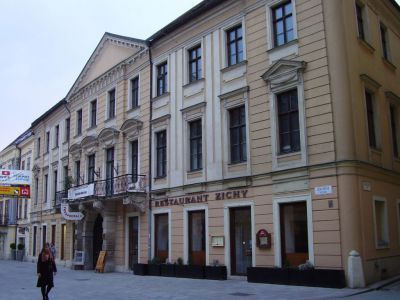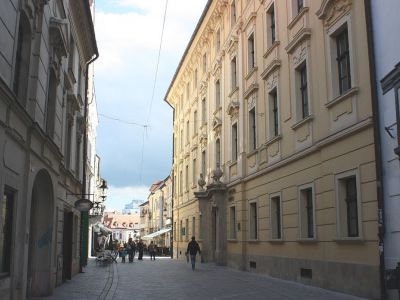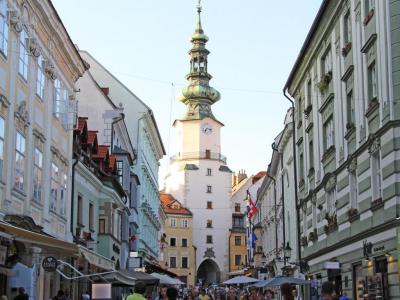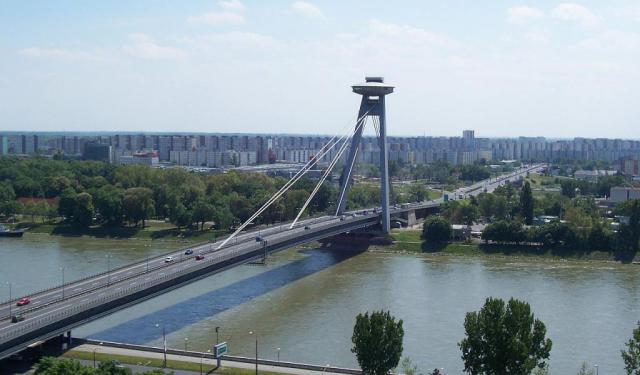Bratislava Old Town (Self Guided), Bratislava
The cityscape of Bratislava is characterized by medieval and other ancient buildings, the lion's share of which are concentrated in the Old Town. The special charm of the city's old quarter never ceases to amaze and is bound to leave anyone absolutely dazzled with its beauty.
The Old Town is indeed Bratislava's historic center, and as such, houses many historic monuments and cultural institutions. Among them: Bratislava's Town Hall – a complex of three buildings erected in the 14th–15th centuries, now hosting the Bratislava City Museum; the Old Slovak National Theater – an 1880s' Neo-Renaissance home to the national drama, opera and ballet troupes; Michael's Gate – the only surviving gate from the city's medieval fortifications, built around 1300; and many more.
The historic center is also rich in Baroque palaces, such as the Primate's Palace, in which in 1805, diplomats of emperors Napoleon and Francis II signed the fourth Peace of Pressburg, after Napoleon's victory in the Battle of Austerlitz.
Other historically or otherwise important sights include:
Hlavne Namestie (Main Square) – the centuries-old hub of the city, replete with numerous landmarks.
Napoleon's Army Soldier Statue – commemorating the two occasions on which Napoleonic army entered the city in the 1800s; one of the most popular photo spots in Bratislava.
Schone Naci (Beautiful Ignaz) – the bronze statue of an eccentric individual who once roamed the streets of Bratislava in the early 20th century.
Cumil Statue – a lovely kind of “Man at Work” statue, adored by children.
Leopold de Pauli’s Palace – a historical edifice in which both Wolfgang Amadeus Mozart and Ferenz Liszt once performed.
Being so compact, Bratislava's Old Town is easy to explore on foot. For a truly enjoyable full- or half-day walk around the area with a culturally-enriching Slovakian experience, take this self-guided tour.
The Old Town is indeed Bratislava's historic center, and as such, houses many historic monuments and cultural institutions. Among them: Bratislava's Town Hall – a complex of three buildings erected in the 14th–15th centuries, now hosting the Bratislava City Museum; the Old Slovak National Theater – an 1880s' Neo-Renaissance home to the national drama, opera and ballet troupes; Michael's Gate – the only surviving gate from the city's medieval fortifications, built around 1300; and many more.
The historic center is also rich in Baroque palaces, such as the Primate's Palace, in which in 1805, diplomats of emperors Napoleon and Francis II signed the fourth Peace of Pressburg, after Napoleon's victory in the Battle of Austerlitz.
Other historically or otherwise important sights include:
Hlavne Namestie (Main Square) – the centuries-old hub of the city, replete with numerous landmarks.
Napoleon's Army Soldier Statue – commemorating the two occasions on which Napoleonic army entered the city in the 1800s; one of the most popular photo spots in Bratislava.
Schone Naci (Beautiful Ignaz) – the bronze statue of an eccentric individual who once roamed the streets of Bratislava in the early 20th century.
Cumil Statue – a lovely kind of “Man at Work” statue, adored by children.
Leopold de Pauli’s Palace – a historical edifice in which both Wolfgang Amadeus Mozart and Ferenz Liszt once performed.
Being so compact, Bratislava's Old Town is easy to explore on foot. For a truly enjoyable full- or half-day walk around the area with a culturally-enriching Slovakian experience, take this self-guided tour.
How it works: Download the app "GPSmyCity: Walks in 1K+ Cities" from Apple App Store or Google Play Store to your mobile phone or tablet. The app turns your mobile device into a personal tour guide and its built-in GPS navigation functions guide you from one tour stop to next. The app works offline, so no data plan is needed when traveling abroad.
Bratislava Old Town Map
Guide Name: Bratislava Old Town
Guide Location: Slovakia » Bratislava (See other walking tours in Bratislava)
Guide Type: Self-guided Walking Tour (Sightseeing)
# of Attractions: 14
Tour Duration: 2 Hour(s)
Travel Distance: 1.2 Km or 0.7 Miles
Author: hollyg
Sight(s) Featured in This Guide:
Guide Location: Slovakia » Bratislava (See other walking tours in Bratislava)
Guide Type: Self-guided Walking Tour (Sightseeing)
# of Attractions: 14
Tour Duration: 2 Hour(s)
Travel Distance: 1.2 Km or 0.7 Miles
Author: hollyg
Sight(s) Featured in This Guide:
- Hlavne Namestie (Main Square)
- Napoleon's Army Soldier Statue
- Old Town Hall
- Bratislava City Museum
- Primate's Palace
- Old Slovak National Theater
- Hviezdoslav Square
- Schone Naci (Beautiful Ignaz) Statue
- Cumil Statue
- Palace of Erdody
- Johann Pálffy Palace
- Palace of Zichy
- Leopold de Pauli’s Palace
- Michael's Tower and Street
1) Hlavne Namestie (Main Square) (must see)
The central point in old town Bratislava, the Main Square, has been the hub of the town for centuries. It is surrounded by landmarks, including Kutscherfeldov Palace, Pawera House, Ungerov Dom, and the Maximillian Fountain. Additionally, tons of restaurants, cafes, and bars in the area keep it bustling.
During the winter months, the Main Square is home to Bratislava's Christmas fair. The entire area is decorated, and vendors set up stalls throughout the square. You'll find souvenirs, boiled wine, beer, and many different Slovak foods.
Over the years, the square has changed names several times. During World War II, it was named to honor Hilter. From 1948 to 1989, it was named for the day Bratislava was liberated by the Red Army - 4 April Square.
The square is home to the Old Town Hall building and several other landmark buildings. Old Town Hall was built in 1599 and is the oldest in the country. Today, it houses a museum all about the town's history.
The Japanese and French Embassy are also located here.
During the winter months, the Main Square is home to Bratislava's Christmas fair. The entire area is decorated, and vendors set up stalls throughout the square. You'll find souvenirs, boiled wine, beer, and many different Slovak foods.
Over the years, the square has changed names several times. During World War II, it was named to honor Hilter. From 1948 to 1989, it was named for the day Bratislava was liberated by the Red Army - 4 April Square.
The square is home to the Old Town Hall building and several other landmark buildings. Old Town Hall was built in 1599 and is the oldest in the country. Today, it houses a museum all about the town's history.
The Japanese and French Embassy are also located here.
2) Napoleon's Army Soldier Statue
The city of Bratislava is filled with unique bronze statues which pop out from the public areas to surprise the masses. Tourists on holiday to the city will want to plan some relaxing time exploring the metropolis and seeking out these fabulous little surprises. The statue of Napoleon’s Army Soldier is located on the main square leaning over a park bench. Visitors enjoy spending time having their pictures taken with the statue. In fact, this is one of the most popular photographic moments in Bratislava. The sculptor, Juraj Meliš, created a figure to commemorate the two occasions when Napoleon’s army entered the city during the 1800s.
The statue earned its name because of its pose. His crossed arms and French Napoleonic hat are reminiscent of Napoleon himself. Some of the other figures, which can be found around the city, are Cumil, Paparazzi and Schone Naci. These whimsical bronze statues are a result of a collaboration among local sculptors who were asked by the town government to add features which would help the city move away from its once austere and communistic appearance. After the first couple statues were installed, more followed, due to their popularity with the locals and tourists.
The statue earned its name because of its pose. His crossed arms and French Napoleonic hat are reminiscent of Napoleon himself. Some of the other figures, which can be found around the city, are Cumil, Paparazzi and Schone Naci. These whimsical bronze statues are a result of a collaboration among local sculptors who were asked by the town government to add features which would help the city move away from its once austere and communistic appearance. After the first couple statues were installed, more followed, due to their popularity with the locals and tourists.
3) Old Town Hall
The Old Town Hall of Bratislava is an excellent example of Gothic architecture. Originally constructed in the 14th century, with the tower dating back from approximately 1370, this is one of the oldest stone buildings in the Slovakian capital. It was originally designed to accommodate soldiers guarding the fortress surrounding the medieval town.
Presently, the Old Town Hall represents a complex of buildings created through merger of several adjacent townhouses, namely: Jacobus' house with a tower, Pawer's house, Unger's house, and the Apponyi palace. Over the ages, the property had undergone numerous reconstructions and served different purposes: as a prison, mint, market, municipal archive, and arsenal depository, until it finally became a town hall in the 15th century. In this capacity it had served until the late 19th century.
During the Renaissance period, the complex passed through various transformations, including those after being damaged by an earthquake and then fire.
Today, it houses the Bratislava City Museum, featuring a collection of historic artifacts: cannonballs; dungeons with instruments of torture; antique weaponry and armour; as well as paintings and miniatures. One of the cannonballs, the one embedded in the tower wall, is of a particular interest to visitors. It has been there since 1809, resulted from the bombardment of the city by the invading Napoleonic army.
In the summer, the courtyard plays host to musical concerts. In the attic of the Apponyi Palace there is a Study Depository of Glass and Ceramics. The beautifully-tiled roof of the building is one of the city's most recognizable landmarks. The top of the Old Town Hall tower is open to visitors, as part of the Bratislava City Museum exhibition, offering a round view of the old part of Bratislava and its environs.
Presently, the Old Town Hall represents a complex of buildings created through merger of several adjacent townhouses, namely: Jacobus' house with a tower, Pawer's house, Unger's house, and the Apponyi palace. Over the ages, the property had undergone numerous reconstructions and served different purposes: as a prison, mint, market, municipal archive, and arsenal depository, until it finally became a town hall in the 15th century. In this capacity it had served until the late 19th century.
During the Renaissance period, the complex passed through various transformations, including those after being damaged by an earthquake and then fire.
Today, it houses the Bratislava City Museum, featuring a collection of historic artifacts: cannonballs; dungeons with instruments of torture; antique weaponry and armour; as well as paintings and miniatures. One of the cannonballs, the one embedded in the tower wall, is of a particular interest to visitors. It has been there since 1809, resulted from the bombardment of the city by the invading Napoleonic army.
In the summer, the courtyard plays host to musical concerts. In the attic of the Apponyi Palace there is a Study Depository of Glass and Ceramics. The beautifully-tiled roof of the building is one of the city's most recognizable landmarks. The top of the Old Town Hall tower is open to visitors, as part of the Bratislava City Museum exhibition, offering a round view of the old part of Bratislava and its environs.
4) Bratislava City Museum
If there's a place to learn about Bratislava's history, it is undoubtedly the Bratislava City Museum. Founded in 1868, by the Bratislava (Pressburg) Beautification Society, this is the oldest continuously operating museum in Slovakia. The museum documents the history of Bratislava from the earliest days until the 20th century.
The initial collections included artifacts donated or bought from the local citizens, and were fitted into four major categories: library, archaeology, ethnography, and fine arts.
In 1896, the Museum presented its exhibits, for the first time outside Bratislava, at the millennial exposition in Budapest, where it was awarded the bronze medal. In the early 20th century, the dissolution of the Austro-Hungarian Empire and the inclusion of Bratislava into Czechoslovakia raised the need of a new identity for the Museum.
In 1923, it came under the administration of the City Hall, and since 1953 has been an independent institution. During the 1960-1970s, the Museum's collection grew further to include archaeological finds, coins, ancient drugs, as well as many other artifacts telling volumes about the history of the society, industry and culture of Bratislava.
Presently, the Museum offers visitors nine permanent exhibitions. It is open year round, six days a week, except Mondays. Feel free to pop in and check out the exhibits of your choice.
The initial collections included artifacts donated or bought from the local citizens, and were fitted into four major categories: library, archaeology, ethnography, and fine arts.
In 1896, the Museum presented its exhibits, for the first time outside Bratislava, at the millennial exposition in Budapest, where it was awarded the bronze medal. In the early 20th century, the dissolution of the Austro-Hungarian Empire and the inclusion of Bratislava into Czechoslovakia raised the need of a new identity for the Museum.
In 1923, it came under the administration of the City Hall, and since 1953 has been an independent institution. During the 1960-1970s, the Museum's collection grew further to include archaeological finds, coins, ancient drugs, as well as many other artifacts telling volumes about the history of the society, industry and culture of Bratislava.
Presently, the Museum offers visitors nine permanent exhibitions. It is open year round, six days a week, except Mondays. Feel free to pop in and check out the exhibits of your choice.
5) Primate's Palace
Today this impressive baroque building is the home of the Mayor of Bratislava, but there is much more history to uncover here.
The Primate's Palace was built from 1777 to 1781 and was designed by Melchoir Hefele. At one time, the palace was home to the primary bishops.
The palace's greatest claim to fame was that it served as a backdrop for signing the fourth Peace of Pressburg in 1805. This document, signed in the building's famous Hall of Mirrors, dissolved the Holy Roman Empire. A bust of Emperor Francis II, the last Roman Emperor, stands near the hall to commemorate the event.
The city purchased the palace in 1903 and began an extensive reconstruction project. During the work, 17th-century tapestries were found behind walls.
For a brief time, the palace was home to the President of Slovakia before his permanent residence was built at Grassalkovich Palace.
The palace is open for tours. You can even see the famous Hall of Mirrors, now used for Bratislava City Council meetings.
The Primate's Palace was built from 1777 to 1781 and was designed by Melchoir Hefele. At one time, the palace was home to the primary bishops.
The palace's greatest claim to fame was that it served as a backdrop for signing the fourth Peace of Pressburg in 1805. This document, signed in the building's famous Hall of Mirrors, dissolved the Holy Roman Empire. A bust of Emperor Francis II, the last Roman Emperor, stands near the hall to commemorate the event.
The city purchased the palace in 1903 and began an extensive reconstruction project. During the work, 17th-century tapestries were found behind walls.
For a brief time, the palace was home to the President of Slovakia before his permanent residence was built at Grassalkovich Palace.
The palace is open for tours. You can even see the famous Hall of Mirrors, now used for Bratislava City Council meetings.
6) Old Slovak National Theater
The Slovak National Theater of drama, opera and ballet is the oldest professional theater in Slovakia. Its history begins shortly after the establishment of the first Czechoslovak Republic in 1918, while the Neo-Renaissance building in Hviezdoslav Square, showing elements of the Austro-Hungarian influence, is a bit older and dates back to the 1880s.
It was designed by the Viennese architects Fellner & Helmer, and opened on 22 September 1886, with the opera Bánk bán by Ferenc Erkel. As a sign of importance, the then-Hungarian prime minister and entire cabinet attended the ceremony. The gala performance was conducted by Ferenc Erkel himself.
Another Austrian sculptor, Viktor Oskar Tilgner, is responsible for creating outside the Ganymede fountain, in 1888. The original building had a seating capacity of 1,000 spectators and was illuminated with 800 gas lamps, plus a 64-light chandelier in the auditorium.
In 1969-1972, the Theater underwent renovation, receiving a modern technical facility behind the old structure.
Performances take place here on most days of the year, so if you're a passionate theater goer, feel free to check the program in advance, so as not to miss anything worthy.
It was designed by the Viennese architects Fellner & Helmer, and opened on 22 September 1886, with the opera Bánk bán by Ferenc Erkel. As a sign of importance, the then-Hungarian prime minister and entire cabinet attended the ceremony. The gala performance was conducted by Ferenc Erkel himself.
Another Austrian sculptor, Viktor Oskar Tilgner, is responsible for creating outside the Ganymede fountain, in 1888. The original building had a seating capacity of 1,000 spectators and was illuminated with 800 gas lamps, plus a 64-light chandelier in the auditorium.
In 1969-1972, the Theater underwent renovation, receiving a modern technical facility behind the old structure.
Performances take place here on most days of the year, so if you're a passionate theater goer, feel free to check the program in advance, so as not to miss anything worthy.
7) Hviezdoslav Square
As with most towns in Europe, Bratislava centers around large squares like the Hviezdoslav Square. It's a beautiful place to walk around, with memorials to national figures and lots of history. The square has been here and part of the Kingdom of Hungary for over 1,000 years.
Historically, the square has been the center of daily life and home to many important institutions. For example, the Cathedrale Notre Dame Cloister and the Slovak National Theater were located here. During medieval times, many of the noble families lived near here.
One of the most impressive monuments is to the square's namesake, Pavol Orszagh Hviezdoslav. He was born in 1849, and Hviezdoslav was a famous Slovak poet, dramatist, and Hungarian patriot. He was from a noble family and served in the Czechoslovak parliament from 1918 to 1920.
The square was recently renovated. Whereas it has historically looked like a small park, today's Hviezdoslav Square looks like the impressive city promenade that it is. It is primarily pedestrian-only, with many trees and quiet greenspaces.
Today, you'll find many important businesses and buildings here. The national opera house still stands here. The German and American embassy buildings are on the square, along with several popular hotels. On the north end of the square, you can find many popular restaurants and bars.
Historically, the square has been the center of daily life and home to many important institutions. For example, the Cathedrale Notre Dame Cloister and the Slovak National Theater were located here. During medieval times, many of the noble families lived near here.
One of the most impressive monuments is to the square's namesake, Pavol Orszagh Hviezdoslav. He was born in 1849, and Hviezdoslav was a famous Slovak poet, dramatist, and Hungarian patriot. He was from a noble family and served in the Czechoslovak parliament from 1918 to 1920.
The square was recently renovated. Whereas it has historically looked like a small park, today's Hviezdoslav Square looks like the impressive city promenade that it is. It is primarily pedestrian-only, with many trees and quiet greenspaces.
Today, you'll find many important businesses and buildings here. The national opera house still stands here. The German and American embassy buildings are on the square, along with several popular hotels. On the north end of the square, you can find many popular restaurants and bars.
8) Schone Naci (Beautiful Ignaz) Statue
Visitors to the city will enjoy searching for the many idiosyncratic statues which have been installed around the town. Schone Naci, or Beautiful Ignaz, represents life in the city at the turn of the century. The real Schone Naci was born in 1897. He was the son of a shoemaker. His eccentric spirit caused him to be memorialized. History says that he would stroll around the Old Town Bratislava, near Michael’s Gate and the Danube River. His attire included a top hat and tails. When he came upon women, he would say “I kiss your hand” in languages including Slovak, German and Hungarian.
The bronze statue greets people just as the real Schone Naci once did. Even though he was a man without financial resources of his own, it is said that he walked the streets of Bratislava dressed as if he were very wealthy. Tourists to the city can spend an entire day, strolling and exploring the streets of this beautiful city, searching for the many wonderful bronze pieces which have been strategically placed for the public to enjoy.
The bronze statue greets people just as the real Schone Naci once did. Even though he was a man without financial resources of his own, it is said that he walked the streets of Bratislava dressed as if he were very wealthy. Tourists to the city can spend an entire day, strolling and exploring the streets of this beautiful city, searching for the many wonderful bronze pieces which have been strategically placed for the public to enjoy.
9) Cumil Statue (must see)
The Čumil Statue in Bratislava is a quirky bronze sculpture crafted by Viktor Hulík. Located at the crossroads of Panská and Rybárska Brána streets near the Main Square, this statue doesn’t depict any real person but comes from Hulík’s creative vision. It shows Čumil, a figure taking a break and peeking out from a manhole, watching people go by and seemingly enjoying the view of young women.
Kids particularly love this statue because they get to touch Čumil’s head and sit on the statue, making it more engaging. Yet, its placement has caused several accidents with passing vehicles bumping into it. To address this, a sign reading "Man at Work" has been placed beside the statue to alert drivers and add a touch of humor for tourists taking pictures.
Čumil is a popular spot for photos in Bratislava, drawing many tourists. Locals have come up with various fun and symbolic stories about why Čumil is there, ranging from jokes about him being nosy to deeper meanings depicting him as a typical Slovak worker. These stories and the statue’s playful nature spark lively conversations among visitors and locals alike.
Even though Čumil is now protected from traffic by a sign, he still faces the wear and tear of being a beloved interactive landmark. There’s even a light-hearted warning for women about mythical risks involving storks. More than just a piece of art, Čumil helps weave the rich cultural stories and legends of Bratislava.
Kids particularly love this statue because they get to touch Čumil’s head and sit on the statue, making it more engaging. Yet, its placement has caused several accidents with passing vehicles bumping into it. To address this, a sign reading "Man at Work" has been placed beside the statue to alert drivers and add a touch of humor for tourists taking pictures.
Čumil is a popular spot for photos in Bratislava, drawing many tourists. Locals have come up with various fun and symbolic stories about why Čumil is there, ranging from jokes about him being nosy to deeper meanings depicting him as a typical Slovak worker. These stories and the statue’s playful nature spark lively conversations among visitors and locals alike.
Even though Čumil is now protected from traffic by a sign, he still faces the wear and tear of being a beloved interactive landmark. There’s even a light-hearted warning for women about mythical risks involving storks. More than just a piece of art, Čumil helps weave the rich cultural stories and legends of Bratislava.
10) Palace of Erdody
The Palace of Erdödy was built in 1770 by Mathew Walch. The building originally comprised four houses, which were initially occupied by Count George Leopold Erdödy, the head of the Hungarian Royal Chamber, and his family. The Erdödy family were decedents of Hungarian nobility with their genealogical lines dating back as far as the 14th century.
The grand structure was converted during the 19th century into a palace for the son of Count George Leopold Erdödy, Jan Nepomuk Erdödy. Originally, the building was erected with three floors and a fourth floor was added at the beginning of the 20th century. It has four wings and an immense central courtyard. The rooms have vaulted ceilings with Rococo stucco. Over the years, the structure has been the home of Hungarian nobility, a concert hall and a government facility. The building is a great example of Rococo style, which is acknowledged for its florid embellishments.
Today, the palace houses a selection of high-end cafes, restaurants, shops and boutiques amidst the historic sites of the town. Visitors to the municipality will appreciate spending the day exploring the many amazing buildings and varied architectural elements which make this place exceptional.
The grand structure was converted during the 19th century into a palace for the son of Count George Leopold Erdödy, Jan Nepomuk Erdödy. Originally, the building was erected with three floors and a fourth floor was added at the beginning of the 20th century. It has four wings and an immense central courtyard. The rooms have vaulted ceilings with Rococo stucco. Over the years, the structure has been the home of Hungarian nobility, a concert hall and a government facility. The building is a great example of Rococo style, which is acknowledged for its florid embellishments.
Today, the palace houses a selection of high-end cafes, restaurants, shops and boutiques amidst the historic sites of the town. Visitors to the municipality will appreciate spending the day exploring the many amazing buildings and varied architectural elements which make this place exceptional.
11) Johann Pálffy Palace
Johann Pálffy Palace, located in the historic Old Town of Bratislava, is an example of late Classicism architecture with a rich Baroque influence. Initially built in the 18th century for Count Leopold Pálffy, a major figure in the armed forces of Empress Maria Theresa and the Count of Pozsony County, the palace has since undergone several transformations and served various significant roles throughout its history.
Originally a residential building for the Pálffy family, the palace has a storied past, featuring as a government mint and hosting one of Wolfgang Amadeus Mozart’s early concerts. It also served as the Austrian embassy. Archaeological excavations on the site have revealed traces of a Gothic structure as well as Roman and Celtic artifacts, indicating the historical depth of the location.
By the middle of the 19th century, the palace was rebuilt by Count Jan Pálffy, who held the position of Bratislava’s highest official at the time. Today, the palace is incorporated into the Bratislava City Gallery, offering a significant cultural venue. It houses three permanent exhibitions that showcase the art and history spanning from the oldest historical periods to contemporary topics. The exhibitions include an impressive collection of original paintings by Dutch and Flemish masters from the 17th and 18th centuries, such as Rembrandt and Rubens.
One of the highlights within the gallery is the statue of the Vajnorská Madonna and Child, an oak carving believed to be from the Regensburg workshop, dating possibly from the late 13th century. Additionally, the gallery has created a permanent exhibition dedicated to Celtic coinage, inspired by significant archaeological findings confirming the presence of a Celtic mint on the site.
The palace is accessible to visitors all year round, with exhibitions spread across three floors and the basement. The courtyard offers a tranquil retreat in the bustling city and is open to the public for free. The entrance reception provides current literature focused on contemporary art events, enriching the educational experience for visitors.
Originally a residential building for the Pálffy family, the palace has a storied past, featuring as a government mint and hosting one of Wolfgang Amadeus Mozart’s early concerts. It also served as the Austrian embassy. Archaeological excavations on the site have revealed traces of a Gothic structure as well as Roman and Celtic artifacts, indicating the historical depth of the location.
By the middle of the 19th century, the palace was rebuilt by Count Jan Pálffy, who held the position of Bratislava’s highest official at the time. Today, the palace is incorporated into the Bratislava City Gallery, offering a significant cultural venue. It houses three permanent exhibitions that showcase the art and history spanning from the oldest historical periods to contemporary topics. The exhibitions include an impressive collection of original paintings by Dutch and Flemish masters from the 17th and 18th centuries, such as Rembrandt and Rubens.
One of the highlights within the gallery is the statue of the Vajnorská Madonna and Child, an oak carving believed to be from the Regensburg workshop, dating possibly from the late 13th century. Additionally, the gallery has created a permanent exhibition dedicated to Celtic coinage, inspired by significant archaeological findings confirming the presence of a Celtic mint on the site.
The palace is accessible to visitors all year round, with exhibitions spread across three floors and the basement. The courtyard offers a tranquil retreat in the bustling city and is open to the public for free. The entrance reception provides current literature focused on contemporary art events, enriching the educational experience for visitors.
12) Palace of Zichy
The Palace of Zichy, aka Ziči or Zičiho Palác as they call it in Slovak, is a beautiful piece of Neo-Classical architecture in the historic heart of Bratislava. Renowned for its elegant, strictly classicist facade and Gothic interior, this multi-storey, Baroque-style edifice reveals architectural details typical of the Louis XVI era. It has a large courtyard, in the center of which there is a fountain crowned with a sculpture of a lion with an open mouth.
The Palace was built between 1770 and 1780 for Count František Ziči (Franz Zichy), for which purpose three other medieval houses had to be demolished. In the early 19th century, from 1817 to 1819, the composer Heinrich Marschner, one of the founders of German Romantic opera, best known for his operas Der Vampyr and Hans Heiling, served as a music teacher for the Zichy family and lived in this Palace.
Since its commissioning, the property has undergone numerous modifications. The latest extensive reconstruction took place in the 1980s, during which it was modernized and adapted for various cultural and social events. Today, the Palace serves as a cultural center and is frequently used on festive occasions, such as wedding ceremonies and concerts.
The Palace was built between 1770 and 1780 for Count František Ziči (Franz Zichy), for which purpose three other medieval houses had to be demolished. In the early 19th century, from 1817 to 1819, the composer Heinrich Marschner, one of the founders of German Romantic opera, best known for his operas Der Vampyr and Hans Heiling, served as a music teacher for the Zichy family and lived in this Palace.
Since its commissioning, the property has undergone numerous modifications. The latest extensive reconstruction took place in the 1980s, during which it was modernized and adapted for various cultural and social events. Today, the Palace serves as a cultural center and is frequently used on festive occasions, such as wedding ceremonies and concerts.
13) Leopold de Pauli’s Palace
The Pauli (Pállfy) Palace is a Baroque-style edifice in the Old Town of Bratislava, located at No. 10 Ventúrská Street, and is not to be confused with the Johann Pálffy Palace in Panská Street.
It was built in 1747, designed by architect Franz K. Romisch, as the seat of Count Leopold Pálffy (Leopold de Pauli), member of the influential aristocratic Hungarian family, who served as the main administrator of the Austro-Hungarian imperial property.
Among other features, the building boasts a large staircase made of hard Kaiserstein (a type of limestone) from the Imperial Quarry (Kaisersteinbruch) near Vienna, and has an interesting portal decorated with a relief, reflecting military career of Leopold Pálffy, the first owner of the house, as a general in the army of Empress Maria Theresa. There are also other war trophies, plus a pair of inner loggias found within the property. Outside, there is a garden with the charming musical Rococo pavilion.
Here, in 1762, Wolfgang Amadeus Mozart, then aged six, played a concert for the local aristocracy, accompanied by his father – the only concert that he gave in the then Hungary. Also, in his time, another great composer, Franz (Ferenz) Liszt, performed here in the first-floor lounge of the Palace, in 1820.
At some point in the past, the Palace was used a mint. From 1993 to 2012, it had housed the Austrian embassy. Presently, the musical pavilion and the Palace itself are both part of the Bratislava University Library.
It was built in 1747, designed by architect Franz K. Romisch, as the seat of Count Leopold Pálffy (Leopold de Pauli), member of the influential aristocratic Hungarian family, who served as the main administrator of the Austro-Hungarian imperial property.
Among other features, the building boasts a large staircase made of hard Kaiserstein (a type of limestone) from the Imperial Quarry (Kaisersteinbruch) near Vienna, and has an interesting portal decorated with a relief, reflecting military career of Leopold Pálffy, the first owner of the house, as a general in the army of Empress Maria Theresa. There are also other war trophies, plus a pair of inner loggias found within the property. Outside, there is a garden with the charming musical Rococo pavilion.
Here, in 1762, Wolfgang Amadeus Mozart, then aged six, played a concert for the local aristocracy, accompanied by his father – the only concert that he gave in the then Hungary. Also, in his time, another great composer, Franz (Ferenz) Liszt, performed here in the first-floor lounge of the Palace, in 1820.
At some point in the past, the Palace was used a mint. From 1993 to 2012, it had housed the Austrian embassy. Presently, the musical pavilion and the Palace itself are both part of the Bratislava University Library.
14) Michael's Tower and Street (must see)
The only surviving gate from the city's medieval walls lies at the end of Michael's Street. Michael's Gate (Michalska Brana) was built around 1300 and once stood with three others leading into town. It is one of the oldest buildings in town.
The tower's baroque exterior is a result of reconstruction works carried out in the 1750s. The statue of Saint Michael and the Dragon was placed at the top during this time.
The gate got its name as the Church of Saint Michael stood just outside the city walls here.
At one point, the city was surrounded by medieval fortifications. Entrance to town was only possible through the four gates, all of which were guarded and fortified. The other gates, now demolished, were the Laurens Gate, Fisherman's Gate on the river Danube, and Vydrica Gate.
At its height, the gate was part of a much larger system of fortifications. They included two rings of city walls, two bastions, a barbican, and a bridge over a moat. The barbican is still present and today has been built into houses. The original bridge over the moat was replaced by a stone one in 1727. Some of the moat is also still visible.
The view from the top of the seven-floor, 51-meter tall tower is spectacular. There is no better place from which to view the old town of Bratislava. To get in the tower, enter through the Museum of Arms. The museum contains excellent exhibits about the fortifications and the history of the city.
The street leading from the Michael's Gate, Michael's Street, is lined with shops and attractions. In addition to the Arms Museum, you'll also find the Pharmacy Museum nearby in a very old shop building. There are also bars, cafes, and restaurants lining the street.
The tower's baroque exterior is a result of reconstruction works carried out in the 1750s. The statue of Saint Michael and the Dragon was placed at the top during this time.
The gate got its name as the Church of Saint Michael stood just outside the city walls here.
At one point, the city was surrounded by medieval fortifications. Entrance to town was only possible through the four gates, all of which were guarded and fortified. The other gates, now demolished, were the Laurens Gate, Fisherman's Gate on the river Danube, and Vydrica Gate.
At its height, the gate was part of a much larger system of fortifications. They included two rings of city walls, two bastions, a barbican, and a bridge over a moat. The barbican is still present and today has been built into houses. The original bridge over the moat was replaced by a stone one in 1727. Some of the moat is also still visible.
The view from the top of the seven-floor, 51-meter tall tower is spectacular. There is no better place from which to view the old town of Bratislava. To get in the tower, enter through the Museum of Arms. The museum contains excellent exhibits about the fortifications and the history of the city.
The street leading from the Michael's Gate, Michael's Street, is lined with shops and attractions. In addition to the Arms Museum, you'll also find the Pharmacy Museum nearby in a very old shop building. There are also bars, cafes, and restaurants lining the street.
Walking Tours in Bratislava, Slovakia
Create Your Own Walk in Bratislava
Creating your own self-guided walk in Bratislava is easy and fun. Choose the city attractions that you want to see and a walk route map will be created just for you. You can even set your hotel as the start point of the walk.
Bratislava Introduction Walking Tour
The capital of Slovakia, Bratislava, is a lovely city straddling the river Danube near the convergence of the Austrian and Hungarian borders. Such closeness had its toll on the city's long and often tumultuous history, in which the Austrians, Croats, Czechs, Germans, Hungarians, Jews, Serbs and Slovaks played their role.
Formerly part of the Hungarian Kingdom, from 1536 to 1783 it was the... view more
Tour Duration: 2 Hour(s)
Travel Distance: 3.4 Km or 2.1 Miles
Formerly part of the Hungarian Kingdom, from 1536 to 1783 it was the... view more
Tour Duration: 2 Hour(s)
Travel Distance: 3.4 Km or 2.1 Miles
Bratislava Architectural Jewels
For centuries, Bratislava has been influenced by European art, culture, and architecture. The juxtaposition of styles here creates a captivating fabric where centuries-old Gothic and Baroque structures harmonize with sleek, modern designs.
The majestic Bratislava Castle, perched on a hill overlooking the Danube River since the 9th century, has seen many renovations over the years. Today, it... view more
Tour Duration: 2 Hour(s)
Travel Distance: 3.5 Km or 2.2 Miles
The majestic Bratislava Castle, perched on a hill overlooking the Danube River since the 9th century, has seen many renovations over the years. Today, it... view more
Tour Duration: 2 Hour(s)
Travel Distance: 3.5 Km or 2.2 Miles
Historical Churches
Although somewhat modest in terms of sights, compared to the neighboring Vienna or Prague, the capital of Slovakia, Bratislava, does have a collection of historical churches that may be of interest to lovers of religious architecture.
Perhaps one of the most prominent landmarks in this area is Saint Martin's Cathedral. Dating back to the mid-15th century, this Gothic-style temple with a... view more
Tour Duration: 2 Hour(s)
Travel Distance: 2.5 Km or 1.6 Miles
Perhaps one of the most prominent landmarks in this area is Saint Martin's Cathedral. Dating back to the mid-15th century, this Gothic-style temple with a... view more
Tour Duration: 2 Hour(s)
Travel Distance: 2.5 Km or 1.6 Miles
The Most Popular Cities
/ view all



